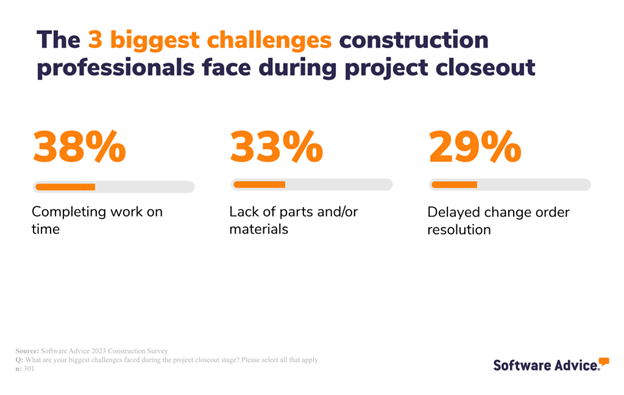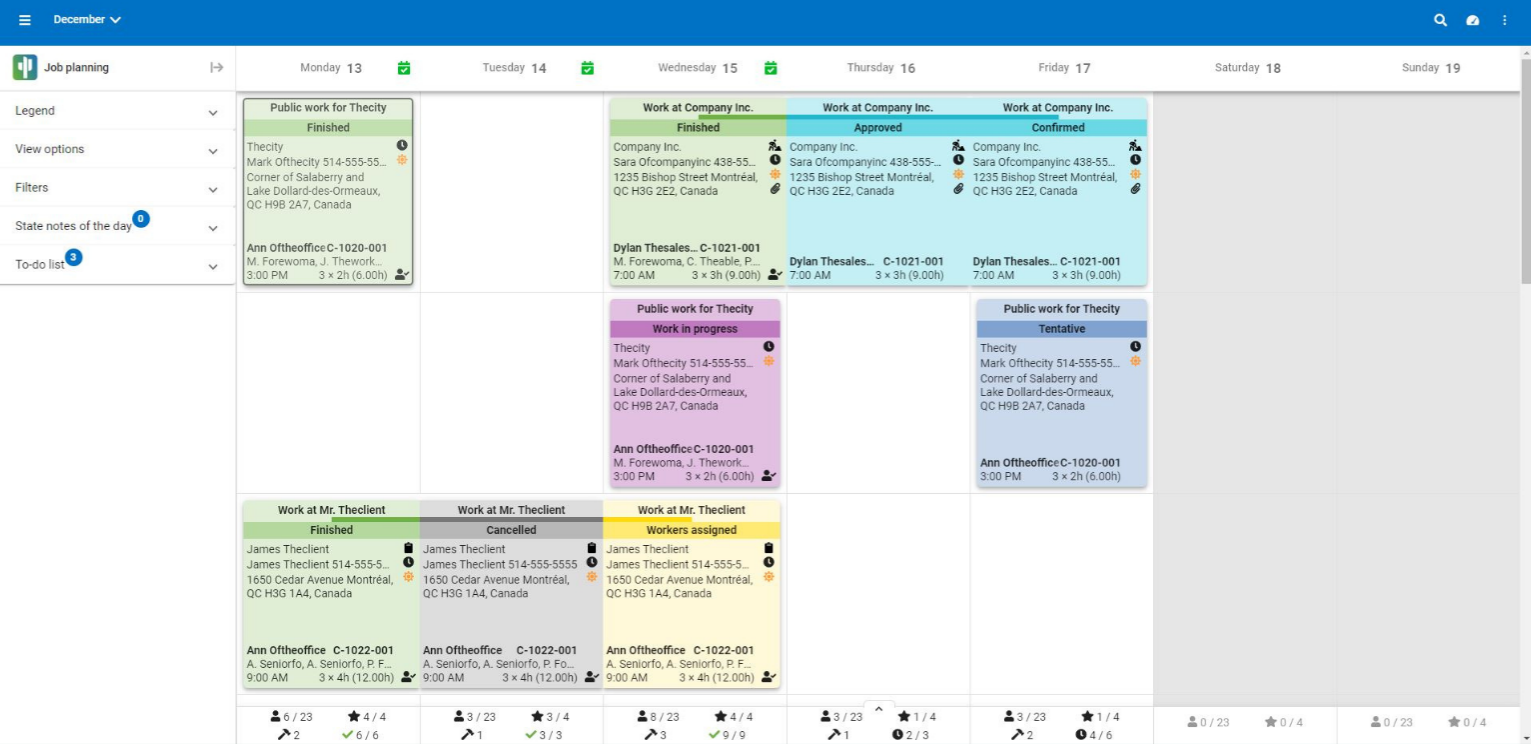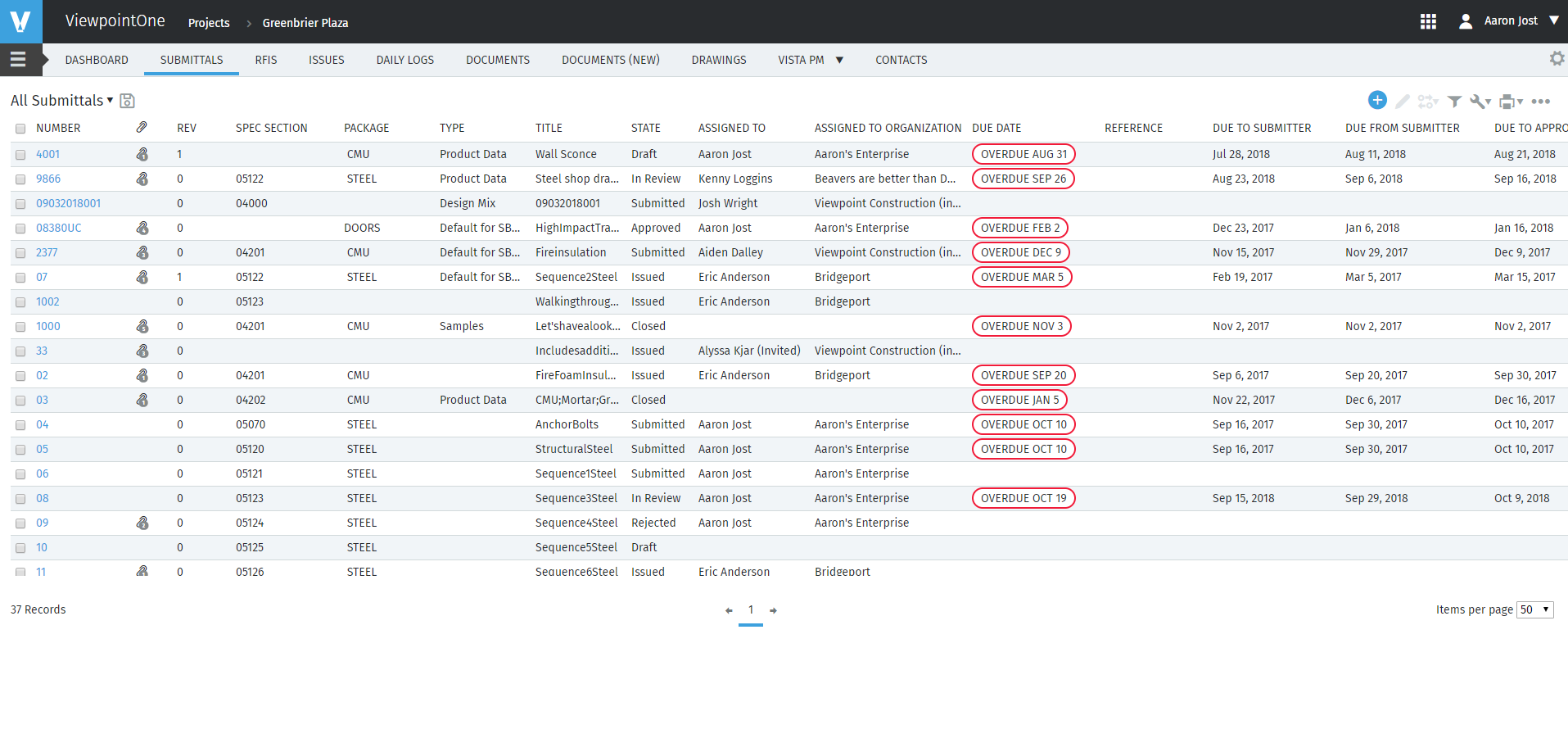Nail Your Construction Project Closeout Every Time With These Tips
Construction project closeout is a big moment. It’s when you, as the builder at a small firm, get to proudly hand off the keys to the happy customer and bask in the satisfaction of a job well done. But that’s only if everything goes well.
In reality, closeout is rife with potential pitfalls. In fact, according to our survey of more than 300 construction professionals (methodology below), the biggest of those challenges include completing work on time (38% of respondents), lack of parts and/or materials (33%), and delayed change order resolution (29%).

But in addition to being a necessary part of any construction project lifecycle, closeout also offers some important benefits, including improving skills (45% of respondents), ensuring customer satisfaction (45%), and confirming that project objectives are being met (43%).
We talked to Ben Gagnon, head of preconstruction for San Diego-based builder SnapADU [1], to get tips for nailing construction project closeouts. As a former project manager for most of his nearly decade-long career in construction, Ben is well aware of how critical—and challenging—it is to get project closeout right when months, or even years, of work all come down to a short period of intense scrutiny.
What is project closeout?
Project closeout is the stage of a construction project when all the loose ends are tied up and the customer signs off on a completed project. This stage is also known as “handing over the keys,” which is an actual part of the closeout. Closeout includes things like closing any open contracts, signing and filing necessary paperwork, walkthrough with the client, completing any last-minute changes requested by the customer, and analyzing project performance.
An expert shares 7 steps for a successful project closeout
Ben Gagnon
head of preconstruction for SnapADU [1]
Now let’s take a look at a step-by-step approach to project closeout that you can use to make sure your next closeout stays on track throughout the project.
1. Gather closeout documents as soon as the project begins
Take it from Gagnon who claims, “Compiling a list of items that need to be addressed as early as possible is the most valuable thing that you can do.”
Common closeout documents to start gathering and storing in a central location on your computer include:
Warranty documents
Punch list
Lien release documents
Financial contracts
It’s fine if these documents are incomplete in the early stages of a project. The important thing is that you have them accounted for and easily accessible so that you can locate and update them as the project progresses.
Bonus tip
If you’re using printed documents, collecting them in a heavy-duty binder emblazoned with your company logo is a great way to stay organized.
2. Address change orders as they come
This will help you avoid getting stuck with a long list of change orders to complete in the final week when you’re still scrambling to finish regularly scheduled tasks as well.
“Identify the issues early on and address them as early as you can, rather than letting that list just accumulate,” says Gagnon. “You're slammed at the very end and the client is involved at that point, so it's really not a good look for you either.”
These change orders will also likely impact the budget and timeline of your construction project, so be sure to communicate with the customer when these changes happen. The project tracking feature in your construction management software can even help you estimate the impact of changes ahead of time.
If a customer requests adding running water to an additional room, for example, you can let them know how much this addition would add to the budget and project deadline before they sign off.
3. Ensure all project deliverables have been completed
This may seem like a no-brainer, but it never hurts to be thorough. Before you can close out your construction project, you need to double-check that all deliverables have been delivered.
Old school construction firms used notepads and pens to scratch deliverables off as they were completed, marking off project milestones manually. You have the benefit of modern, mobile-friendly construction apps to help you stay organized, save paper, and automate time-consuming tasks like updating budgets and schedules.

The worksite progress screen in Cactusoft construction software (Source)
The task management feature in your construction management software makes it easy to track task interdependencies, progress toward task completion, progress toward overall completion, task owners, and more. More on this later.
4. Double-check project specifications
During preconstruction, you should have put together a comprehensive list of project specifications (type of material, quantity of material, precise measurements, etc.) with the customer. Any changes to these specifications should be communicated and recorded in your construction project management software.
The final walkthrough is not the time to explain to your customer that you ran out of marble countertops halfway through the kitchen build and had to switch over to laminate. Or that their walk-in closet is now a duck-in closet because some ductwork had to be rerouted.
Before you even think about the final walkthrough, double-check that all project specifications have been met or that changes have been discussed and settled with the customer.
5. Walk through with the customer
Now that all of your closeout documents are in order and all deliverables (original and change requests) have been completed to specification, it’s time for the big day: the final walkthrough with the (hopefully) satisfied customer.
Even if you’ve been doing everything right all along, this can still be a nerve wracking experience. Will they have second thoughts about that palm frond ceiling fan at the last minute? Will they still stand by their unusual choice for lime green paint in the living room when they see what it looks like in the light of day?
As long as you’ve done your due diligence, you’ll have much less to lose sleep over.
Bonus tip
You certainly don’t need to wear a three-piece suit for the walkthrough, but cleaning up all the empty water bottles on the job site and putting on a clean collared shirt with your company logo adds a professional touch.
6. Signing of final documents and handing over of keys
So you’ve walked through the completed construction project, let the customer ask all the questions they want and kick the proverbial tires. Now it’s the moment of truth, when it’s time to get the signature on the dotted line (either on a printed form if you’re old school or digitally if you’re using modern software).
When you hand over the keys, it’s also a great time to show your customer all the warranty documents so they know where they are if they run into any trouble.
Gagnon says that his company gives customers ongoing access to their client portal so that they can also access these documents digitally years later.
“It simplifies things for us. In two years when a client comes back to us and asks for X, Y, and Z, we can just point them to the portal and all that information is housed there,” he said. “They can lose that packet in a move, or if they're selling the house and they give it to somebody else, it’s easier to keep track of.”
7. Final project assessment
Once you have a final sign-off and you’ve been paid in full for all of your hard work, it can be tempting to close the door on that project and direct all of your attention to the next one. But it’s important to take a little time to do a quick project assessment to see what went right, what went wrong, and what you want to do differently next time.
Did the project finish on time (or close to on time)? If not, where did it go off the rails? Were you close to the original budget? If not, what caused the overruns? What kind of feedback did the customer have during closeout? If they had any complaints, how can you address those complaints for future projects?
Tracking budget and timeline data in your construction management software can also help you identify trends over time. For example, if you notice that 90% of your projects have been completed within a week of their promised deadline over the past five years, you can use that information in your marketing material to attract new customers.
Bonus tip
Send a survey to all customers when the project is complete. Even negative feedback is helpful if you use it to improve.
Tools for project closeout
Decades ago, construction firms of all sizes were forced to complete projects using notepads and spreadsheets. And while you could conceivably keep track of project closeout using those same tools now if your firm is fairly small and you’re handling one small project at a time, this is a bad idea.
Modern construction project management software helps users organize necessary documents digitally, track project progress and forecast budget and timelines, centralize communication, and more.
What is Construction Management Software? - Software Advice Video Buyer Guide (Source)
Let’s take a closer look at a few construction software features that are especially helpful with project closeout.
Client portal. This feature lets construction firms give customers restricted access to their construction software so that they can communicate updates, share documents, and grant access to project schedules, for example. This can help firms communicate with clients throughout the project lifecycle, reducing friction once you get to the closeout stage.
Customer portal overview in Buildertrend construction software [2]
Document management. This feature helps construction teams digitally store and organize all necessary documents for a project. It can also be used to share documents internally and externally, and collect digital signatures. This feature can streamline the document management for project closeout.

Document management in Viewpoint Team construction management software (Source)
Project tracking. Perhaps the biggest advantage of using dedicated construction software instead of a spreadsheet is the AI-powered ability to update budgets and timelines as the project goes on. This feature can help ensure that there are no surprises for the client once you reach the closeout stage.
Project tracking in Procore construction software [3]
Want some free help selecting the right construction software for your firm? Our experienced software advisors are ready to help:
How to connect to an advisor at Software Advice (Source)
Go forth and close out
The bottom line is this: If you wait until the final stages of a project to start thinking about closeout, it’s already too late. It pays enormous dividends to keep an eye on closeout from day one to take some of the stress out of an inherently stressful process.
It’s important to remember that every firm will handle their closeout a little differently based on their size, number of projects, financing, and even regional regulations and requirements. However, if you follow these guidelines you should be able to nail your closeout every time:
Start the closeout process early, and keep at it throughout the project lifecycle.
Tackle change orders as they come, and update your client on how these changes affect their bottom line.
Use the project tracking feature of your construction software to eliminate surprises.
Use the client portal in your construction software to communicate updates and share documents throughout the project.
Don’t forget to hold a project post mortem to track successes and failures to improve future projects.
Construction software is key to a successful project closeout, and you can find the best software for your firm’s specific needs in our directory.
Sources
Buildertrend Customer Portal Overview, Renovations Unlimited (YouTube)
Note: The applications selected in this article are examples to show a feature in context and are not intended as endorsements or recommendations. They have been obtained from sources believed to be reliable at the time of publication.
Survey methodology
* Software Advice's 2023 Employee Feedback Survey was conducted in January 2023 among 301 U.S. respondents to learn more about construction software and its benefits. Respondents were screened to be a construction professional with a role in their firm’s selection/purchase of construction software.